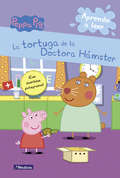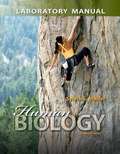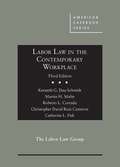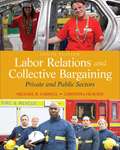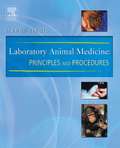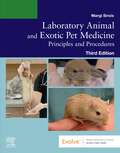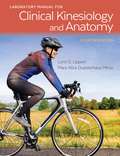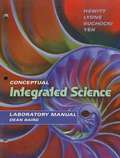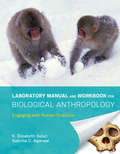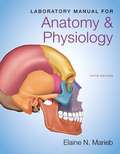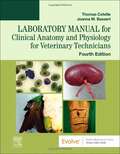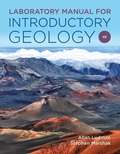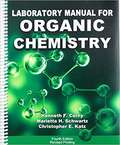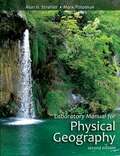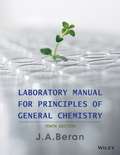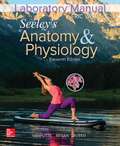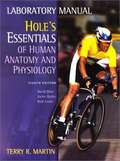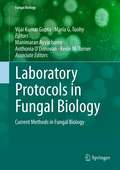- Table View
- List View
La tortuga de la Doctora Hámster (Peppa Pig. Pictogramas #Volumen)
by Hasbro EoneUn nuevo título de la colección Aprendo a leer con Peppa. Se incluyen pictogramas para facilitar la lectura y actividades para reforzar el aprendizaje. La Doctora Hámster ha traído unas mascotas a clase. Los alumnos están tan emocionados que no se dan cuenta de que la pequeña tortuga ha desaparecido. ¿Dónde estará? ¡Para que los más peques se diviertan leyendo y aprendiendo vocabulario!
La vecina misteriosa (¡Arriba la Lectura!, Level L #2)
by Jeremy Tugeau Loretta WestLa familia de Lila tiene nuevos vecinos. Quiere ser amiga de Ana, su nueva vecina, pero es un poco misteriosa. ¿Por qué Ana es tan extraña? NIMAC-sourced textbook
La velocidad de la luz y el sonido (¡Arriba la Lectura!, Level P #30)
by Sue BursztynskiNIMAC-sourced textbook
La veterinaria (¡Arriba la Lectura!, Level G #49)
by Annette Smith Lindsay EdwardsNIMAC-sourced textbook. Sampi no se siente bien, y por eso debe ir al veterinario. Mira cómo lo examinan para ver qué le pasa.
La vida de Rosa Parks (¡Arriba la Lectura!, Level O #54)
by Cynthia MercatiConoce la historia de una mujer valiente que luchó por la justicia y la igualdad para hacer del mundo un lugar mejor. NIMAC-sourced textbook
La vida en el desierto (¡Arriba la Lectura!, Level J #21)
by Lloyd KajikawaEl desierto es un lugar my seco y caluroso. Aprende cómo viven los animales en el desierto NIMAC-sourced textbook
La vida en los yacimientos de oro (¡Arriba la Lectura!, Level V #61)
by Pamela Rushby Dale NewmanNIMAC-sourced textbook
Lab Manual For Human Biology (Thirteenth Edition)
by Sylvia MaderContains laboratory exercises and activities in relation to human body and other biology texts
Labor Law in the Contemporary Workplace (American Casebook)
by Catherine L. Fisk Kenneth G. Dau-Schmidt Martin H. Malin Roberto L. Corrada Christopher David Ruiz CameronLabor Law in the Contemporary Workplace prepares students for the practice of labor law by introducing them to the principles of American labor law and many of the issues that labor attorneys face. The book is organized around contemporary problems as a means of teaching the core principles of labor law. Although the primary focus of the book is the National Labor Relations Act, considerable attention is given to the Railway Labor Act and public-sector labor laws because of their growing importance in contemporary practice. The third edition takes account of changes in the law since the first edition and second editions were published and in particular new interpretations of the National Labor Relations Act by the National Labor Relations Board and recent state restrictions on public sector collective bargaining.
Labor Relations and Collective Bargaining: Private and Public Sectors
by Michael R. Carrell Christina HeavrinBring your best case to the table by putting theory into practice with this guide to labor relations, unions, and collective bargaining. Labor Relations and Collective Bargaining: Cases, Practice, and Law introduces readers to collective bargaining and labor relations. This text is concerned with application, as well as coverage of labor history, laws, and practices.
Laboratory Animal Medicine: Principles and Procedures
by Margi SiroisComprehensive coverage of a variety of topics such as animal species, the laboratory setting, regulatory guidelines, and ethical considerations prepares readers for a career in laboratory animal medicine. Familiarizes readers with the handling, behavior, nutrition, and lab and treatment procedures for a large variety of common and nontraditional laboratory animals. The consistent organization of each species chapter makes it easy for readers to quickly identify similarities and differences among various laboratory animals. Laboratory exercises are included in a perforated section at the end of the book, allowing users to apply their knowledge and develop job skills. Features a wealth of user-friendly features such as a two-color design, learning objectives, key points, and review questions. Provides detailed information on specific legal and ethical requirements of lab animal care and use, including the ethics of pain management. Convenient boxes and tables provide quick access to,important anatomic and physiologic data for each species.
Laboratory Animal and Exotic Pet Medicine
by Margi SiroisLearn the veterinary technician's role in the care of exotic pets and animals used in biomedical research! Laboratory Animal and Exotic Pet Medicine: Principles and Procedures, 3rd Edition helps you gain the knowledge and skills needed to ensure animal health and well-being. It covers animal husbandry, restraint and handling, and diseases, and provides guidelines to key clinical procedures such as blood collection, medication administration, anesthesia, and diagnostic imaging. Research-related information addresses the ethical concerns of exotic pet ownership, as well as the benefits and humane use of animals in research. Written by noted veterinary technology educator Margi Sirois, this text is a must-have resource for all caretakers of lab animals. Comprehensive coverage prepares you to work with all types of animals by addressing a wide variety of species including rats, mice, rabbits, guinea pigs, ferrets, hamsters, gerbils, nonhuman primates, amphibians, fish, reptiles, birds, farm animals, and cats and dogs; it also covers topics such as animal species, the laboratory setting, regulatory guidelines, and ethical considerations. Consistent organization of each species chapter makes it easy to quickly identify similarities and differences among various laboratory animals. Current information on legal, moral, and ethical issues includes legal requirements, the protocols guiding lab animal use, animal exploitation, and animal rights. Discussion of specific uses for each species in biomedical research provides a perspective that helps you explain the benefits of animal use in providing high-quality research data. Technician Notes highlight important points and provide helpful tips to improve your knowledge and skills. Learning objectives, key points, and chapter review questions make studying easier. NEW! Comprehensive coverage of poultry includes the increasingly popular backyard chickens, as well as commonly performed procedures and in-depth information on housing, restraint, nutrition, common diseases, diagnostics, and therapeutics. NEW photographs show the latest technology available in laboratory and exotic animal medicine.
Laboratory Investigations for AP Environmental Science (Second Edition)
by William MolnarLaboratory Investigations for AP Environmental Science (Second Edition) by William Molnar
Laboratory Manual For Clinical Kinesiology And Anatomy (Fourth Edition)
by Lynn S. Lippert Mary Alice Duesterhaus MinorDivided into three sections, it will help you to prepare for lab, guide you through lab activities, and serve as an after-lab review that ensures you build a solid knowledge base of kinesiology.
Laboratory Manual For Conceptual Integrated Science
by Paul G. Hewitt John A. Suchocki Jennifer Yeh Suzanne A. LyonsThis guide provides a variety of hands-on activities and experiments that complement the Active Explorations throughout the text.
Laboratory Manual and Workbook for Biological Anthropology
by Sabrina C. Agarwal K. Elizabeth SoluriThe perfect lab solution. A vividly illustrated, flexible, and topically balanced manual with a critical-thinking approach
Laboratory Manual for Anatomy & Physiology (Fifth Edition)
by Elaine N. MariebThis laboratory manual is designed for instructors who teach a two-semester introductory anatomy & physiology course, but do not require the full range of laboratory exercises found in Marieb’s best-selling Human Anatomy & Physiology Lab Manuals (Cat, Fetal Pig, and Main).
Laboratory Manual for Clinical Anatomy and Physiology for Veterinary Technicians
by Joanna M. Bassert Thomas P. ColvilleLearn to apply your A&P learning in the lab setting with the Laboratory Manual for Clinical Anatomy and Physiology for Veterinary Technicians, 4th Edition. This practical laboratory resource features a variety of activities, such as terminology exercises, illustration identification and labelling, case presentations, and more to help reinforce your understanding of veterinary anatomy and physiology. The laboratory manual also features vivid illustrations, lists of terms and structures to be identified, and step-by-step dissection guides to walk you through the dissection process. <p><p> Clinically oriented learning exercises introduce you to the language of anatomy and physiology as you identify structures and learn concepts. <p><p>Clear, step-by-step dissection instructions for complex organs such as the heart familiarize you with the dissection process in a very visual, easy-to-understand format. <p><p>Learning objectives, the clinical significance of the content, and lists of terms and structures to be identified appear at the beginning of each chapter. <p><p>Review activities and study exercises are included in every chapter to reinforce important information. <p><p>High-quality, full-color illustrations provide a solid understanding of the details of anatomic structure.
Laboratory Manual for Introductory Geology
by Stephen Marshak Allan LudmanThis lab manual offers a variety of activities for an active, applied student experience and increased flexibility for instructors. Every lab includes "What Do You Think?" exercises in which students apply the course concepts to real-world scenarios. New Geotours Google Earth exercises get students exploring and analyzing real-world sites. A new, unique chapter on global change in which students explore how the Earth will evolve during their lifetime has been added to this edition.
Laboratory Manual for Organic Chemistry
by Kenneth F Cerny Marietta H Schwartz Christopher E KatzThis new manual takes students of organic chemistry through a multitude of basic laboratory techniques such as reaction setup, reflux, distillation, recrystallization, thin layer chromatography and many others. Modern spectroscopic techniques such as UV-Vis, FT-IR, and NMR are reviewed and utilized as a part of many experiments. As with all editions of this manual, the authors include pre-laboratory hand-in assignments and post experiment study questions.
Laboratory Manual for Physical Geography
by Alan H. Strahler Mark PotosnakThis student-friendly, interactive lab manual presents activities and experiments that enhance students’ ability to both visualize and understand physical geographic topics. In a clear and concise tone, the manual requires students to first apply information they learned and then to critically evaluate the information.
Laboratory Manual for Principles of General Chemistry (Tenth Edition)
by Jo Allan BeranPre-laboratory Assignment Questions emphasize the chemical principles presented in the introduction of the experiment. Representative calculations, data analysis, and points of emphasis required for the completion of the Experimental Procedure are also addressed in the Pre-laboratory Assignment. ?h Laboratory Questions help promote a deeper understanding of the experiment and help students recognize where chemical principles can be used for interpreting unexpected data or ?turning points? in the experiment. In-depth discussion of lab techniques and easy-to-reference techniques icons: Lab techniques are covered in the front of the manual and are assigned an icon. The icons are placed in the margin of the text at the appropriate point at which to use the technique. ?h Safety and Disposal Icons: Icons contained in the Experimental Procedures indicate safety cautions and provide information regarding the correct disposal of test solutions. Strong coverage/emphasis on safety. Illustrations and clear procedures make it a good reference for students. Offers Dry Labs that can be done outside the lab setting. Offers easy custom pub options. Extensive background information offered within each lab. Can be used with any text.
Laboratory Manual for Seeley's Anatomy and Physiology (11th Edition)
by Eric WiseLaboratory Manual For Seeley's Anatomy And Physiology, Eleventh Edition
Laboratory Manual: Hole's Essentials of Human Anatomy and Physiology
by Terry R. MartinThis laboratory manual is designed for students with minimal backgrounds in the physical and biological sciences who are pursuing careers in allied health fields.
Laboratory Protocols in Fungal Biology
by Maria G. Tuohy Anthonia O’donovan Vijai Kumar Gupta Kevin M. Turner Manimaran AyyachamyLaboratory Protocols in Fungal Biology presents the latest techniques in fungal biology. This book analyzes information derived through real experiments, and focuses on cutting edge techniques in the field. The book comprises 57 chapters contributed from internationally recognised scientists and researchers. Experts in the field have provided up-to-date protocols covering a range of frequently used methods in fungal biology. Almost all important methods available in the area of fungal biology viz. taxonomic keys in fungi; histopathological and microscopy techniques; proteomics methods; genomics methods; industrial applications and related techniques; and bioinformatics tools in fungi are covered and complied in one book. Chapters include introductions to their respective topics, list of the necessary materials and reagents, step-by-step, readily reproducible laboratory protocols, and notes on troubleshooting. Each chapter is self-contained and written in a style that enables the reader to progress from elementary concepts to advanced research techniques. Laboratory Protocols in Fungal Biology is a valuable tool for both beginner research workers and experienced professionals.
